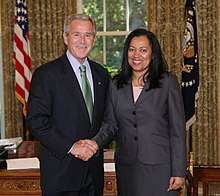Fátima Veiga
Maria de Fátima da Veiga (born June 22, 1957) is a Cape Verdean politician and diplomat. Veiga was the foreign minister from 2002–2004. She was the first female foreign minister in Cape Verde's history.
Maria de Fátima da Veiga | |
|---|---|
 Ambassador Veiga with President Bush after presenting her credentials as ambassador, August 16, 2007 | |
| Ambassador of Cape Verde to Cuba | |
| In office 2001–2002 | |
| Minister of Foreign Affairs | |
| In office 2002–2004 | |
| President | Pedro Pires |
| Preceded by | Manuel Inocêncio Sousa |
| Succeeded by | Víctor Borges |
| Ambassador of Cape Verde to the United States | |
| Ambassador of Cape Verde to France | |
| Assumed office 2014 | |
| Preceded by | José Armando Filomeno Ferreira Duarte |
| Personal details | |
| Born | 22 June 1957 Mindelo, São Vicente, Portuguese Cape Verde |
Veiga was born on the island of São Vicente. She later attended some higher education institutes including the University of Aix-en-Provence in the south of France, the German Foundation in Berlin, the Prague and in Brazil. In 1980, she started to work for the Cape Verdean Ministry of External Affairs. Between 2001 and 2002, she was the Ambassador of Cape Verde to Cuba. When she was a foreign minister, she visited Paris from January 9 to 12, 2002.
For a few years in 2007 she was the Ambassador of Cape Verde to the United States. She presented her credentials to President Bush on August 16, 2007.[1]
Since February 20, 2014, she is the Capeverdean ambassador to France. She succeeded José Armando Filomeno Ferreira Duarte who was the longest serving ambassador to France.
Notes
- "Diplomatic List: Order of Precedence and Date of Presentation of Credentials". United States Department of State. December 17, 2008. Retrieved 2009-01-04.
| Political offices | ||
|---|---|---|
| Preceded by Manuel Inocêncio Sousa |
Foreign Minister of Cape Verde 2002–2004 |
Succeeded by Víctor Borges |
| Preceded by José Armando Filomeno Ferreira Duarte |
Capeverdean Ambassador to France 2014–present |
Succeeded by Incumbent |